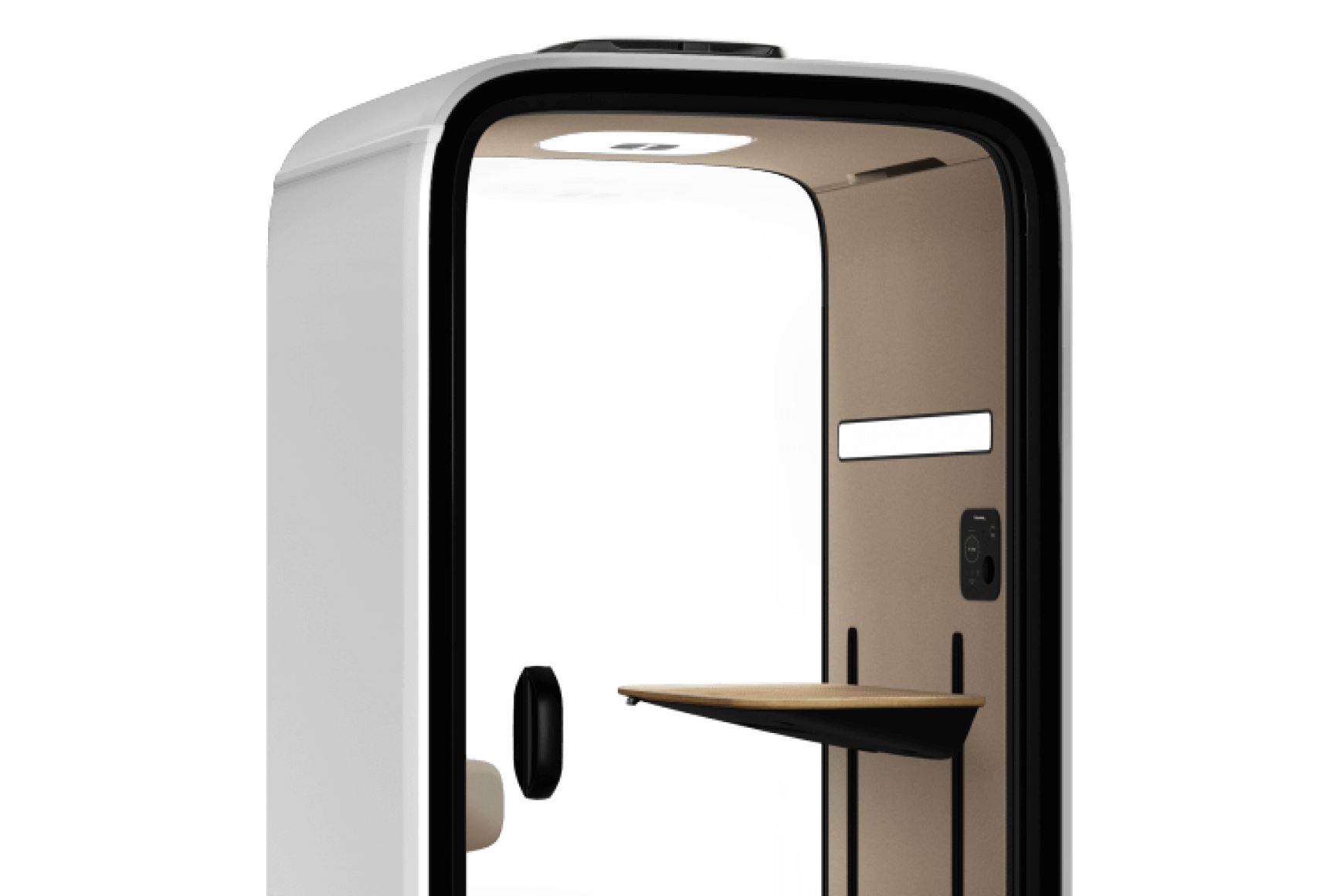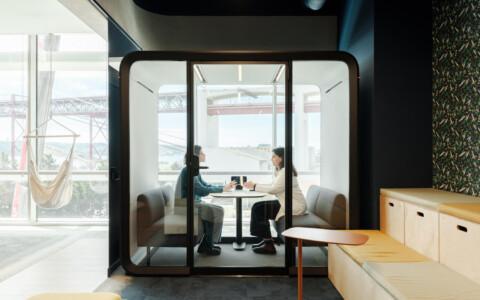For many knowledge workers, an office job means working in an open environment where privacy and distraction-free work are rare luxuries. As a result, many office workers take full advantage of working from home. Good office design is a key solution to combat distracting and unergonomic office noise. Most importantly, companies should pay close attention to improving the acoustics of their offices.
Key highlights
- Distracting office noise is a major cause of satisfaction among modern knowledge workers.
- Focusing on improving office acoustics while responding to the needs of office workers improves their well-being and productivity.
- Good workplace acoustics is a combination of office space design, smart technology, and policies for working in the office.
Poor office acoustics leads to employee dissatisfaction
As the number of workstations in the same office space increases, so does the risk of sound becoming a distraction. Companies can mitigate the adverse effects of poor office acoustics by designing the office space with different employee needs and work activities in mind.
The Finnish Ministry of the Environment has provided research-based guidelines for planning and implementing acoustic conditions in buildings, including office spaces. They have found that a central cause of office workers’ dissatisfaction is distracting office noise and a lack of privacy. The most notable source of distracting noise is colleagues, rather than other external sounds, such as ventilation.
Why do office acoustics matter?
Improving office acoustics reduces the negative effects of noise on productivity. When working in a noisy office environment, employees can still carry out routine work, whereas cognitively demanding tasks that require effort from one’s working memory are significantly harder.
The effects of office noise are not individual but cause similar challenges to all employees. Therefore, it is the responsibility of employers to ensure that the acoustics of a workplace promote everyone’s well-being.

The severity of distracting noise is more pronounced in open-plan offices than in single-person office rooms. Fortunately, the negative effects of office noise can be mitigated while improving privacy by redesigning the office space, for example, by providing enough private spaces for employees.
In an open office, the acoustics should enable face-to-face conversations at a reasonable distance from the other person. In contrast, other sounds from five or more meters away should not hinder focused work.
Modern offices are not designed for focused work
A Leesman’s Research and Insights Unit survey found that many office environments do not support critical work activities, such as planned meetings, focused work, and creative thinking, as effectively as home environments.
One particularly persistent issue hampering office workers’ productivity concerns acoustic privacy and noise levels. According to Leesman’s surveys, dissatisfaction with office noise has been a notable issue for a decade, yet no notable improvement has been made.
Dissatisfaction with office noise discourages employees from returning to the office.
One ongoing trend accelerated by the pandemic is the growth of videoconferencing at the expense of telephone communication. However, workplace design has yet to catch up with this growing need for videoconferencing and remote meeting spaces. Ultimately, offices need to adapt to the trend towards hybrid work by offering their workers higher quality, employee-centered designs.
How to measure distracting speech in an office?
One way to measure the intelligibility of speech in the office environment is with the speech transmission index (STI). An STI of 0 means that speech is entirely unintelligible in the environment. When speech is wholly intelligible, the STI index is 1.
With an STI value above 0.5, sounds in the nearby environment are noticeable enough to distract. Therefore, a lower STI value promotes distraction-free and focused work in an office setting, whereas meeting rooms and other spaces dedicated to communication benefit from a higher STI value.
The intelligibility of speech and its ability to distract can be reduced with:
- sound-masking technology that produces a subtle ambient sound in the frequency of speech
- sound-absorbing materials and furniture, such as carpets and acoustic panels
- fewer hard surfaces that reflect sound waves, causing them to spread more effectively
Guidelines for open office acoustics
Improving office acoustics is multifaceted, and no single solution can fix poor acoustics in an open office. It all starts with an office design that puts the employees’ needs and various work activities first. Here are some ways to improve the acoustics of an office.
Equip the office with private spaces
An open office space should have enough private rooms for tasks that require intense focus or discussions that could disturb others in the same environment. These include:
- videoconferencing and phone calls
- group work requiring discussion with coworkers
- focus-intensive work prone to distractions
- confidential work tasks
If the soundproofing qualities of a closed workspace exceed 25 dB, you can place it near other workstations in the office without internal sounds distracting others nearby. The soundproofing qualities of private workspaces, such as office pods and booths, are even greater when equipped with sound masking technology.
Framery smart pods and booths provide modern knowledge workers with the private and distraction-free spaces they need and deserve. With industry-leading soundproofing of 30db speech reduction (according to the ISO 23351-1 standard), Framery smart pods promote employee productivity and well-being. Equipped with our Framery Sound Masking System™, the pods improve workplace acoustics throughout the office.
Establish rules on how different zones in the office are used
For the design of an office to promote privacy and distraction-free work, employees should play by shared rules concerning the use of different areas. For example, when designing the office, certain areas can be dedicated to quiet work only and then separated from collaborative spaces where employees are free to have open discussions without fear of distracting others.
With a mix of open office areas, quiet focus rooms, and meeting spaces, the office space can be tailored to different work activities. Consider establishing a policy for remote and in-person days at the office to avoid overcrowding the office space.
Reduce speech intelligibility with sound-absorbing materials
Position absorptive materials, such as curtains, carpets and acoustic panels, on at least two non-parallel surfaces to avoid horizontal sound reflections. When furnishing the office space with soundproof pods and booths, you can place them near workstations as long as the pods’ speech level reduction is greater than 25 dB.

Explore all Framery pods
Use sound masking systems to create subtle background noise
Sound masking is among the most effective ways to reduce the intelligibility of distracting speech of colleagues. Focusing on speech in particular is essential as it is the most distracting type of background noise; as long as speech is intelligible, it is a source of distraction during focus-heavy work.
A sound masking system combats the distractions caused by noisy coworkers by creating ambient noise that is optimized to match the frequency of a human voice. The Framery One Compact, Framery Four, and Framery Six smart pods and booths improve the acoustic environment of the workplace with our Framery Sound Masking System™. The sound masking system is embedded into the pods and creates an unnoticeable ambient sound optimized to make speech less intelligible.
FAQ about office acoustics
What is office acoustics?
Office acoustics refers to the study and management of sound in an office environment with the ultimate goal of creating a comfortable and productive workspace. You can promote good office acoustics by controlling noise levels and enhancing sound quality by using materials, design elements, and technologies strategically throughout the office. Effective office acoustics minimizes distractions from external noise, such as the sounds of colleagues speaking. Promoting good office acoustics improves speech privacy, reduces stress, and leads to greater overall workplace satisfaction.
What are the best ways to improve acoustics at the office?
Improving office acoustics is a combination of design strategies and technology. Firstly, make sure to equip the office with enough private spaces, such as office pods. Reduce the intelligibility of distracting noise with sound-absorbing materials and furniture. Remember to take full advantage of smart office technology, such as sound masking systems, to mitigate the effects of poor acoustics on knowledge workers.
Get started today
Design your own
Customize your pod and make it your own with our pod configurator.

Get a quote
Find your nearest representative to hear about pricing and get a quote for your project.

Try a pod
Visit one of our global showrooms to try any of our Framery pods for yourself.





